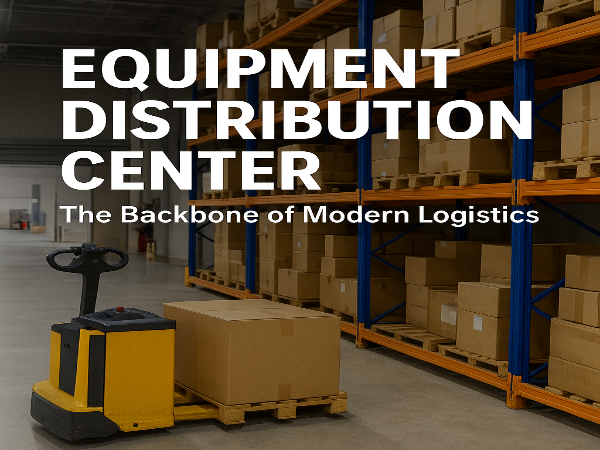Equipment Distribution Center: The Backbone of Modern Logistics
How Centralized Equipment Management Powers Efficiency, Accuracy, and Growth

An equipment distribution center is a specialized facility where businesses store, manage, and distribute equipment, tools, and spare parts to different locations or users. Unlike a regular warehouse, which mainly holds finished products for sale, an equipment distribution center focuses on the efficient handling of operational resources such as machinery, tools, and components. These centers optimize inventory, reduce downtime, and ensure that organizations—from construction firms to hospitals—have the right equipment at the right time, improving productivity and lowering operational costs.
Introduction
In today’s highly competitive business world, efficiency is everything. Companies are under constant pressure to cut costs, reduce delays, and meet rising customer demands. While most people associate warehouses with consumer goods or retail products, there’s another equally important part of supply chain logistics: the equipment distribution center (EDC).
An equipment distribution center serves as a strategic hub where all tools, spare parts, machines, and critical equipment are stored, tracked, maintained, and dispatched. These facilities are essential for industries that rely on timely access to specialized gear, including manufacturing, construction, healthcare, energy, defense, and telecommunications. Without them, businesses risk delays, downtime, and inefficiency.
This article explores the concept of equipment distribution centers in detail—covering their functions, benefits, challenges, technology integration, and future trends—while showing why they are vital to modern supply chain management.
What is an Equipment Distribution Center?
An equipment distribution center is a dedicated facility that goes beyond simply storing items. Its role is to:
Receive incoming equipment from manufacturers or suppliers.
Inspect, document, and categorize assets.
Store them in an organized and trackable way.
Dispatch equipment quickly when requested by field offices, technicians, or customers.
Handle returns, repairs, and maintenance.
Think of it as the nerve center of operational equipment management. Where a retail distribution center ensures products reach customers, an equipment distribution center ensures that employees and departments always have the physical resources they need to operate efficiently.
The Difference Between a Warehouse and an Equipment Distribution Center
While the terms are sometimes used interchangeably, there are clear distinctions:
| Aspect | Warehouse | Equipment Distribution Center |
|---|---|---|
| Purpose | Store products for resale or distribution | Manage, maintain, and distribute operational equipment |
| Focus | Inventory of goods | Tools, spare parts, machinery, and resources |
| Processes | Stocking, picking, packing, shipping | Receiving, inspection, maintenance, allocation, repair, dispatch |
| Users | Retailers, wholesalers, customers | Employees, technicians, service providers, healthcare staff |
The critical difference lies in functionality. An EDC doesn’t just hold stock—it ensures the right tools and machines are available, functional, and deployed at the right time.
Functions of an Equipment Distribution Center
Equipment Receiving and Inspection
When new equipment arrives, it is inspected for quality, verified against purchase orders, and logged into inventory systems.
Storage and Inventory Management
Equipment is stored systematically, often using barcodes, RFID, or IoT tags for real-time tracking.
Maintenance and Repairs
Unlike warehouses, EDCs often have a service area for preventive maintenance and quick repairs before redistribution.
Equipment Dispatch and Allocation
EDCs quickly supply tools and equipment to various departments, sites, or technicians when needed.
Returns and Reverse Logistics
When equipment comes back, it is checked, refurbished, or replaced.
Tracking and Reporting
Modern EDCs provide analytics on equipment usage, downtime, and lifecycle management.
Why Businesses Need Equipment Distribution Centers
Minimizing Downtime – Field operations cannot afford to halt because a part or tool is unavailable.
Centralized Control – Ensures proper tracking, reduces theft or misplacement.
Cost Efficiency – Bulk purchasing and centralized repairs save money.
Scalability – Supports business expansion by efficiently supplying more locations.
Improved Productivity – Workers have reliable access to what they need, when they need it.
Technology in Modern Equipment Distribution Centers
Today’s equipment distribution centers are powered by technology:
Warehouse Management Systems (WMS): Software to manage stock, equipment, labor, and logistics.
RFID and IoT: Real-time tracking of equipment movement and usage.
Automated Storage and Retrieval Systems (AS/RS): Robotics and conveyors for efficient storage.
Predictive Analytics: Forecasting equipment demand and maintenance needs.
Mobile Applications: Allow technicians to request, check, or return equipment remotely.
Benefits of an Equipment Distribution Center
Operational Benefits
Faster equipment deployment
Higher accuracy in inventory tracking
Better planning and resource allocation
Financial Benefits
Reduced cost of downtime
Lower repair and replacement expenses
Optimized procurement strategy
Strategic Benefits
Stronger supply chain resilience
Improved service delivery to customers
Competitive advantage in industries where timing matters
Challenges in Managing Equipment Distribution Centers
Even with advanced systems, EDCs face obstacles:
Complex inventory: Hundreds of equipment types with varying sizes, conditions, and lifespans.
Maintenance burden: Preventive upkeep requires skilled staff and resources.
Logistics costs: Transporting heavy equipment can be expensive.
Forecasting errors: Misjudging demand can cause shortages or surpluses.
Integration with other systems: Linking EDC operations with ERP or field service systems is often complex.
Industries That Rely on Equipment Distribution Centers
Construction: Tools, heavy machinery parts, safety gear.
Healthcare: Surgical instruments, diagnostic machines, medical equipment.
Telecommunications: Cables, routers, servers, field tools.
Manufacturing: Spare parts, machine tools, calibration devices.
Defense and Military: Tactical equipment, weapons systems, spare parts.
Energy Sector: Oil rigs, wind farms, power plants—tools and parts are mission-critical.
Best Practices for Running an Effective Equipment Distribution Center
Implement a robust WMS to manage inventory and resources.
Use barcode or RFID technology for accurate tracking.
Conduct regular maintenance cycles to ensure equipment readiness.
Provide employee training on handling and logistics systems.
Establish a returns and refurbishment process for used equipment.
Monitor KPIs such as turnaround time, downtime, and equipment utilization.
The Future of Equipment Distribution Centers
With digital transformation sweeping across supply chains, the future of EDCs looks promising:
AI & Machine Learning will predict demand and automate decisions.
Robotics & Drones will handle picking, inspections, and transport.
Sustainability Practices like recycling and energy-efficient storage will gain traction.
Cloud-based platforms will integrate EDCs with global supply chain networks.
Businesses that embrace these innovations will gain a clear competitive edge.
Conclusion
The equipment distribution center is no longer just a warehouse; it is a mission-critical hub for businesses that depend on equipment availability and reliability. By combining advanced technology, efficient logistics, and proactive maintenance, EDCs ensure that tools, spare parts, and machinery are always where they are needed most.
From healthcare to construction, from defense to manufacturing, industries across the globe rely on these centers to reduce downtime, cut costs, and improve service quality. As supply chains grow more complex and technology evolves, equipment distribution centers will continue to play an increasingly vital role in operational success.



